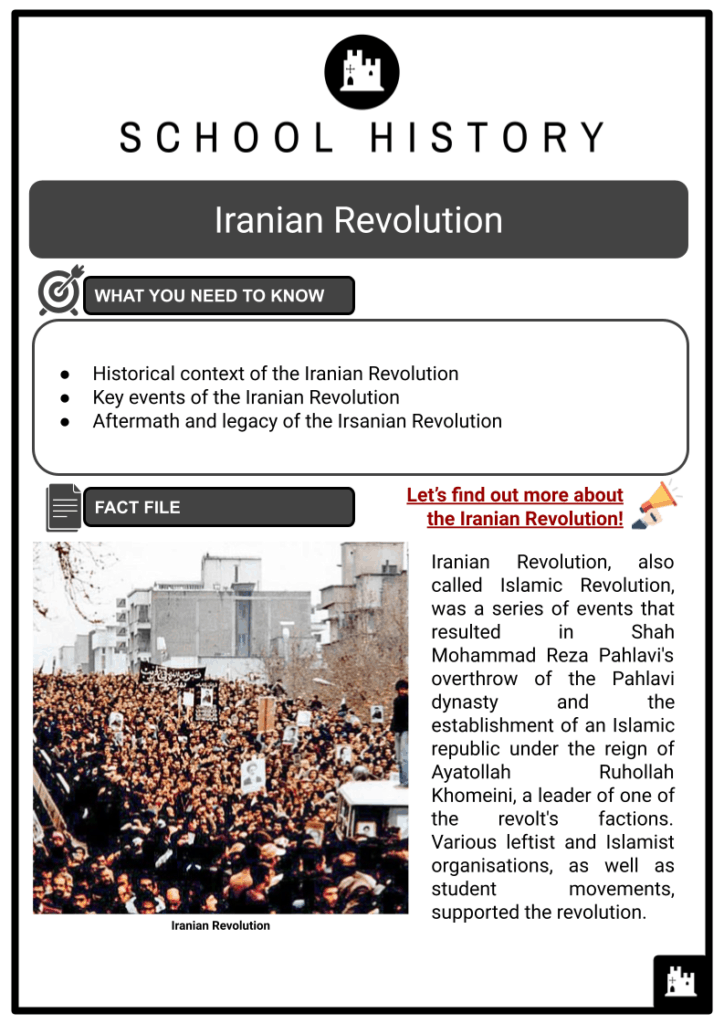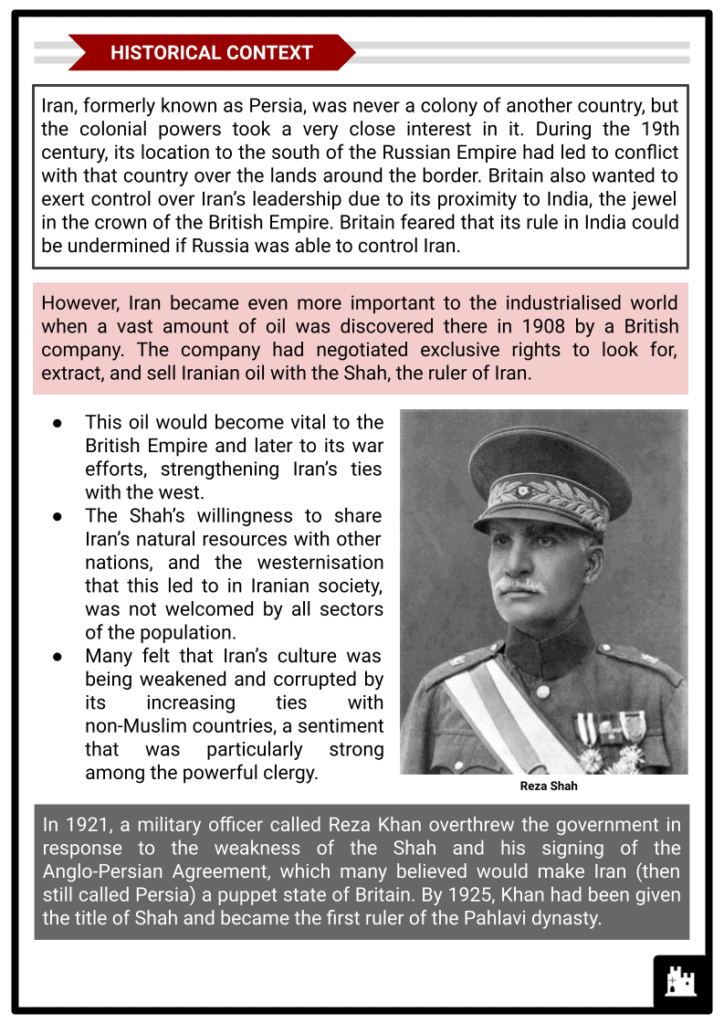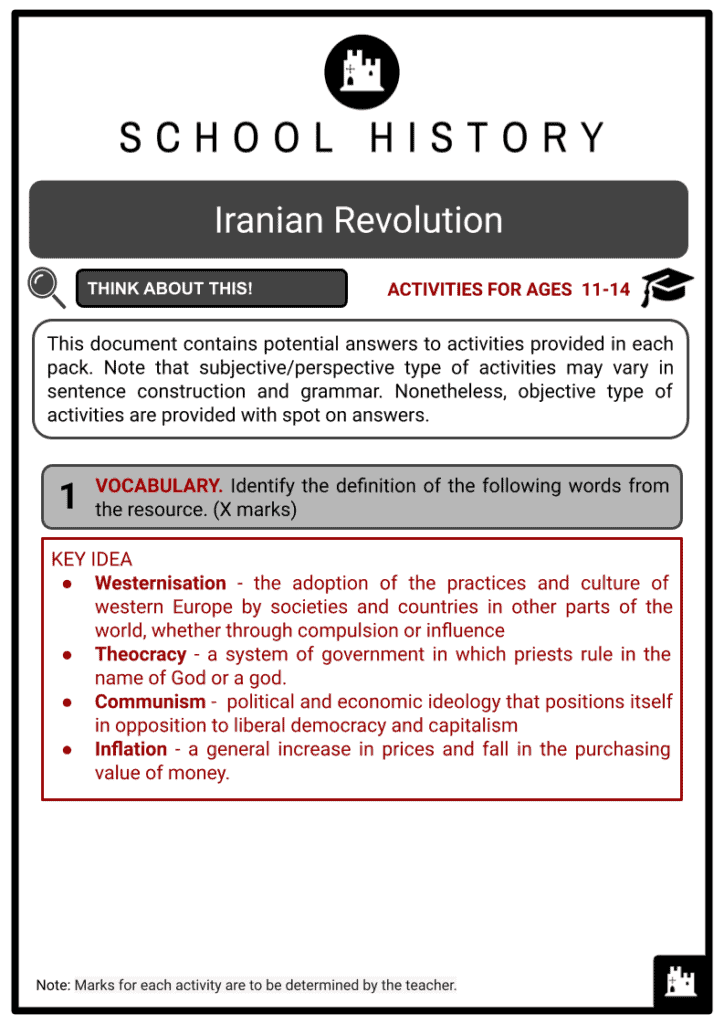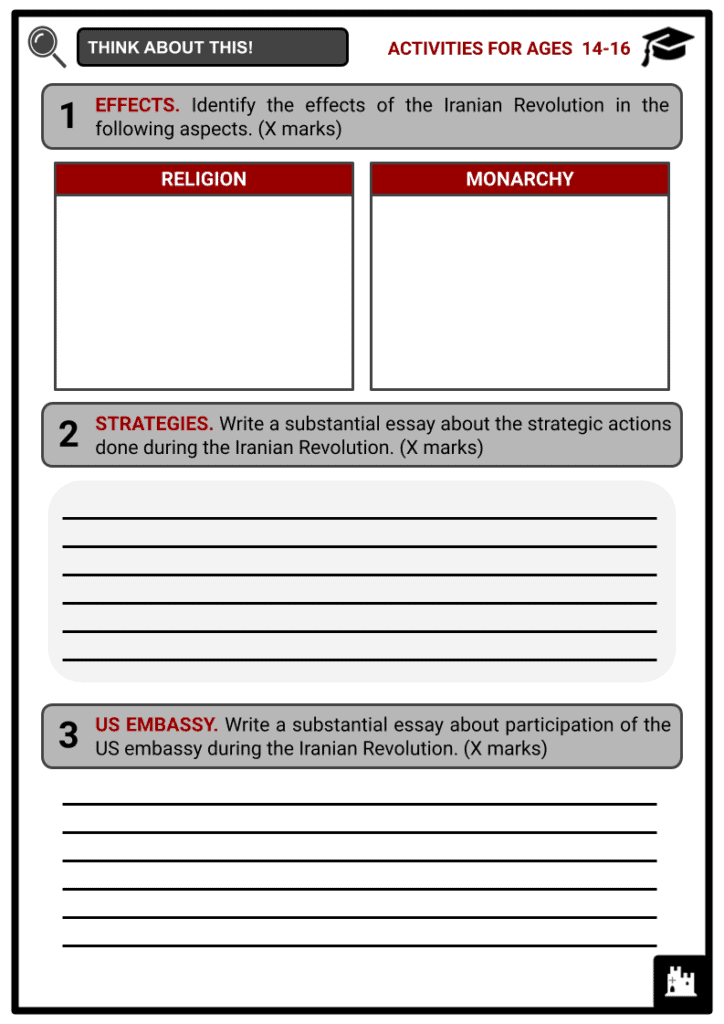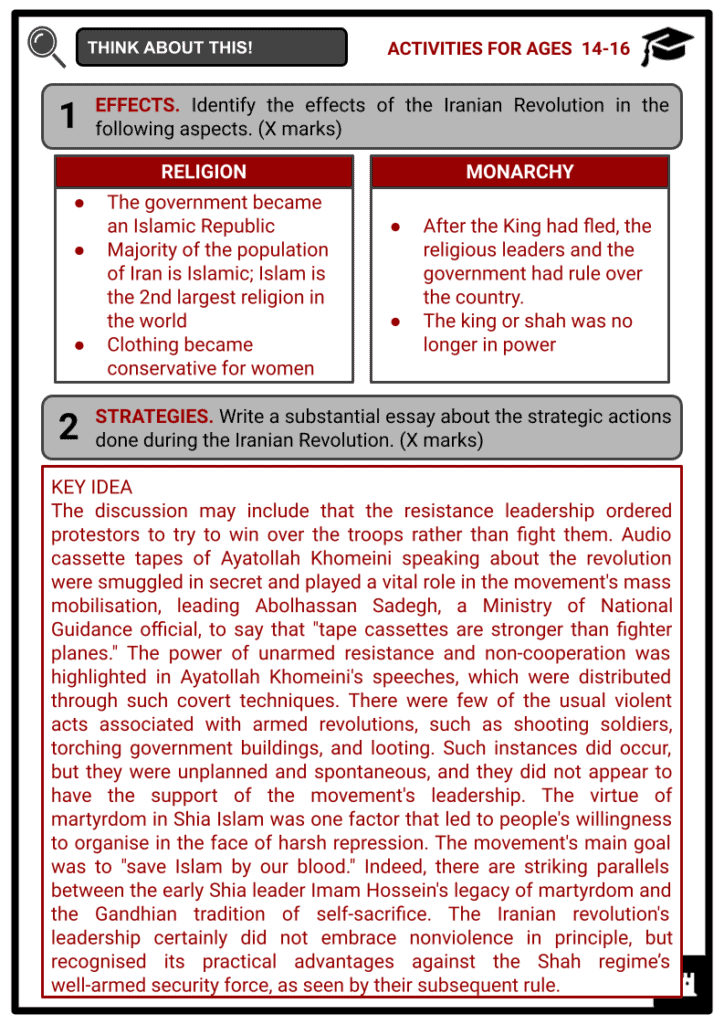Download Iranian Revolution Worksheets
Do you want to save dozens of hours in time? Get your evenings and weekends back? Be able to teach the Iranian Revolution to your students?
Our worksheet bundle includes a fact file and printable worksheets and student activities. Perfect for both the classroom and homeschooling!
Table of Contents
Add a header to begin generating the table of contents
Summary
- Historical context of the Iranian Revolution
- Key events of the Iranian Revolution
- Aftermath and legacy of the Iranian Revolution
Key Facts And Information
Let’s know more about the Iranian Revolution!
- Iranian Revolution, also called Islamic Revolution, was a series of events that resulted in Shah Mohammad Reza Pahlavi's overthrow of the Pahlavi dynasty and the establishment of an Islamic republic under the reign of Ayatollah Ruhollah Khomeini, a leader of one of the revolt's factions. Various leftist and Islamist organisations, as well as student movements, supported the revolution.
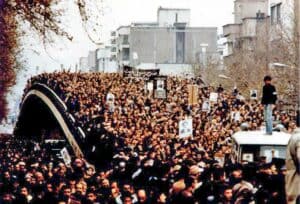
Historical Context
- Iran, formerly known as Persia, was never a colony of another country, but the colonial powers took a very close interest in it. During the 19th century, its location to the south of the Russian Empire had led to conflict with that country over the lands around the border. Britain also wanted to exert control over Iran’s leadership due to its proximity to India, the jewel in the crown of the British Empire. Britain feared that its rule in India could be undermined if Russia was able to control Iran.
- However, Iran became even more important to the industrialised world when a vast amount of oil was discovered there in 1908 by a British company. The company had negotiated exclusive rights to look for, extract, and sell Iranian oil with the Shah, the ruler of Iran.
- This oil would become vital to the British Empire and later to its war efforts, strengthening Iran’s ties with the west.
The Shah’s willingness to share Iran’s natural resources with other nations, and the westernisation that this led to in Iranian society, was not welcomed by all sectors of the population.
Many felt that Iran’s culture was being weakened and corrupted by its increasing ties with non-Muslim countries, a sentiment that was particularly strong among the powerful clergy. - In 1921, a military officer called Reza Khan overthrew the government in response to the weakness of the Shah and his signing of the Anglo-Persian Agreement, which many believed would make Iran (then still called Persia) a puppet state of Britain. By 1925, Khan had been given the title of Shah and became the first ruler of the Pahlavi dynasty.
- Access to Iran’s oil fields became a pressing concern for the British in World War II. Now allied with Russia in the form of the USSR, Britain could not risk Iran falling under the control of its enemies. Reza Shah was rumoured to have German sympathies, and so he was forced to abdicate by the Allies. His son, Mohammad Reza Pahlavi, became the new Shah. In 1951 a new prime minister was elected, Mohammad Mosaddegh.
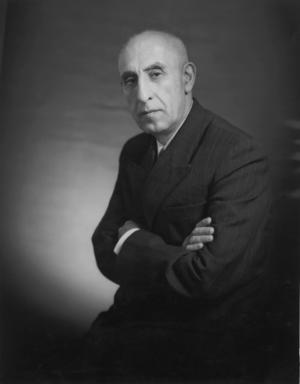
- He promised to nationalise Iran’s oil industry, taking it back from foreign control. He also wanted to reduce the powers of the Shah.
- Mosaddegh was supported by Iran’s communist party, although he was not a communist himself, and this was enough for the British secret service, MI6, to persuade the American C.I.A. that they needed to remove the prime minister from power.
- A coup was orchestrated with the backing of the Shah, and Mosaddegh was put under house arrest. From then on, the Shah’s rule grew more autocratic.
- Through the 1960s, he rushed through unpopular modernisation programmes in what was known as the ‘White Revolution’. The cleric known as the Ayatollah Khomeini spoke out against the Shah’s reforms and was forced into exile. The oil boom of the 1970s saw the Shah’s family become tremendously wealthy, but the economic benefits were not felt by many of the population.
Key Events
- During the 1970s, opposition to the Shah in Iran came from a variety of sources. Muslim clerics did not like his westernising and modernisation, intellectuals objected to his autocratic rule, and there were many rural workers who had been forced into the cities by his urban-focused reforms. The decade had seen an oil boom, but also high inflation. The government’s attempts to control inflation had caused living standards to plateau.
- Opponents of the Shah’s regime were often censored or even tortured. An alliance between the disparate groups of opponents was formed, with the aim of overthrowing the Shah. In exile, Ayatollah Khomeini preached against the Shah, becoming a figurehead for the opposition movement.
- In January 1978, a Tehran-based newspaper, Ettela’at, published an article criticising Khomeini. A group of students in the city took to the streets to protest in support of the Ayatollah, and they were soon joined by larger-scale demonstrations against the Shah’s regime.
- The Shah himself, and the world at large, was shocked by the scale of the protests and the strength of feeling against him.
He moved to suppress them, and his security forces were so brutal in dispersing the demonstrations that many protestors were injured and some were even killed.
The deaths created martyrs for the revolutionary cause, and also had another knock-on effect. - Shi’a Islam, the official religion of Iran, has a tradition of holding memorials for the dead 40 days after their passing. So 40 days after the first protests, memorials were held for the slain protestors, sparking more protests and more deadly repression. Then 40 days after this, there were more memorials, and more protests and the cycle continued into the summer of 1978.
- On 19 August 1978, terrorists set fire to a cinema, killing hundreds of people. The true motives behind the attack have never been uncovered: the Shah’s supporters blamed Islamic Marxists, while revolutionaries claimed the Iranian secret service had carried out the attack on the Shah’s orders. The attack on the cinema was one of the key triggers for the revolution, as the protests that followed it escalated and led to the Shah’s downfall.
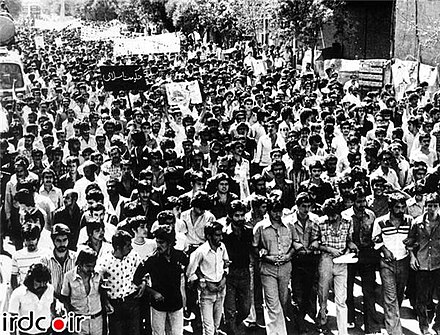
- The Shah imposed martial law in Tehran on 8 September 1978. After the army opened fire on thousands of demonstrators, dozens were killed.
- The day came to be known as Black Friday. The following week saw workers go on strike at oil refineries and government offices.
- When this mushroomed into a general strike at the end of October, the Iranian industry was paralysed.
- On November 5th, there was rioting in Tehran, targeting buildings and businesses that were perceived as westernised.
- The Shah tried to placate the protestors, dismissing many representatives of his government who had been accused of corruption.
- He also agreed to give striking workers pay rises.
- Despite the conciliatory measures from the Shah, the protests continued. In the Muslim month of Muharram, starting that year on 2 December, millions of people marched calling for the end of the Shah’s rule and the return of Ayatollah Khomeini. Khomeini was at that time in France, where he was using the western media to publicise the anti-Shah cause. Although his intention was to turn Iran into a theocracy, a country governed by religious law, Khomeini allowed the west to think that he only wanted democracy.
- The Shah decided that it was time for him to leave Iran. On 16 January 1979, he appointed a new prime minister, Shapour Bakhtiar, whom he hoped would be able to rein in the Ayatollah and stop him imposing a theocracy. He then took his family and left for Egypt. Huge crowds again took to the streets, this time in celebration at the Shah’s departure.
- Prime Minister Bakhtiar invited Ayatollah Khomeini to return to Iran, which he did on 1 February 1979.
- The leader of the revolution was greeted rapturously.
- However, he immediately denounced Bakhtiar’s government and nominated his own replacement prime minister, Mehdi Bazargan.
- With Bakhtiar and Khomeini at a standoff, support for Bakhtiar melted away.
- By February 11th, the armed forces had declared that they would remain neutral and not fight for him.
- This marked the end of Bakhtiar’s government and the official end to the monarchy in Iran.
Aftermath and Legacy
- On 1 April 1979, Ayatollah Khomeini, now in effective charge of Iran, named the country an Islamic Republic. The clergy moved to distance themselves from the left-wing intellectuals who had been their allies in the revolution, and Iran returned to being a conservative Muslim nation after decades of westernisation. Women’s rights were rolled back and strict dress codes were enforced.
- Islamic law was enforced by the Ayatollah’s newly created Revolutionary Guard, whose brutality often surpassed that seen under the Shah. By the end of the year, a new constitution enshrined religion as being dominant in the state and gave the leading cleric, at that time Khomeini himself, extensive powers.
- Throughout most of 1979, the Revolutionary Guards — then an informal religious militia formed by Khomeini to prevent a repeat of the CIA-backed coup of Mosaddegh — engaged in similar activity, aimed at intimidating and repressing political groups not controlled by the ruling Revolutionary Council and its sister organisation, the Islamic Republican Party, both clerical organisations loyal to Khomeini. The level of violence and brutality was frequently higher than it had been under the Shah.
- The militias and clergy they supported made every attempt to eradicate Western cultural influence, and many of the country's Western-educated elite departed due to persecution and violence. This anti-Western feeling culminated in the November 1979 seizure of 66 Americans at the US embassy in Tehran by a group of Iranian demonstrators demanding the extradition of the Shah, who was receiving medical treatment in the US at the time.
- Khomeini's supporters might claim to be as "anti-imperialist" as the political left by seizing the embassy. They were able to suppress most of the regime's left-wing and moderate opponents as a result of this.
- With his death in 1989, Khomeini's reign as Supreme spiritual leader came to an end, and he was succeeded by Hojatoleslam Seyed Ali Khamenei, who had been president since August 1981. Khamenei was at the forefront of a movement of revolutionary purists who were passionate about not compromising on revolutionary ideals.
- Iran's Revolutionary Guards have grown to prominence as a political and economic power. Iran became increasingly isolated as a result of US sanctions, a situation that persists today. While Iran's economy is still heavily based on oil, many Iranians are dissatisfied with the government's alleged inflation and corruption. Iran is still an Islamic state today.

